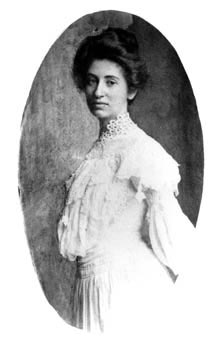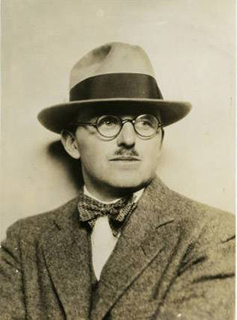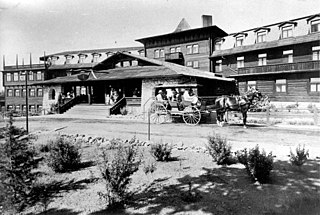
The Spanish Colonial Revival style is an architectural stylistic movement arising in the early 20th century based on the Spanish colonial architecture of the Spanish colonization of the Americas.

Mary Elizabeth Jane Colter was an American architect and designer. She was one of the very few female American architects in her day. She was the designer of many landmark buildings and spaces for the Fred Harvey Company and the Santa Fe Railroad, notably in Grand Canyon National Park. Her work had enormous influence as she helped to create a style, blending Spanish Colonial Revival and Mission Revival architecture with Native American motifs and Rustic elements, that became popular throughout the Southwest. Colter was a perfectionist, who spent a lifetime advocating and defending her aesthetic vision in a largely male-dominated field.

The New Mexico State Capitol is the seat of government of the U.S. state of New Mexico, located in its capital city of Santa Fe. It houses both chambers of the New Mexico Legislature and the offices of the Governor, Lieutenant Governor, and Secretary of State. The building is one of only eleven state capitols without a dome, and the only circular state capitol in the United States, for which it is commonly known as "the Roundhouse".

The House of the Temple is a Masonic temple in Washington, D.C., United States, that serves as the headquarters of the Scottish Rite of Freemasonry, Southern Jurisdiction, U.S.A.

Moorish Revival or Neo-Moorish is one of the exotic revival architectural styles that were adopted by architects of Europe and the Americas in the wake of Romanticist Orientalism. It reached the height of its popularity after the mid-19th century, part of a widening vocabulary of articulated decorative ornament drawn from historical sources beyond familiar classical and Gothic modes. Neo-Moorish architecture drew on elements from classic Moorish architecture and, as a result, from the wider Islamic architecture.

John Gaw Meem IV was an American architect based in Santa Fe, New Mexico. He is best known for his instrumental role in the development and popularization of the Pueblo Revival Style and as a proponent of architectural Regionalism in the face of international modernism. Meem is regarded as one of the most important and influential architects to have worked in New Mexico.

The Pueblo Revival style or Santa Fe style is a regional architectural style of the Southwestern United States, which draws its inspiration from Santa Fe de Nuevo México's traditional Pueblo architecture, the Spanish missions, and Territorial Style. The style developed at the beginning of the 20th century and reached its greatest popularity in the 1920s and 1930s, though it is still commonly used for new buildings. Pueblo style architecture is most prevalent in the state of New Mexico; it is often blended with Territorial Revival architecture.

The New Mexico Museum of Art is an art museum in Santa Fe governed by the state of New Mexico. It is one of four state-run museums in Santa Fe that are part of the Museum of New Mexico. It is located at 107 West Palace Avenue, one block off the historic Santa Fe Plaza. It was given its current name in 2007, having previously been referred to as The Museum of Fine Arts.
Scottish Rite Cathedral and Scottish Rite Temple are names commonly applied to buildings used by Ancient and Accepted Scottish Rite, a body associated with Freemasonry. It may refer to any of a number of specific buildings, including:

The National Park Service Southwest Regional Office, also known as National Park Service Region III Headquarters Building, is located at 1100 Old Santa Fe Trail in Santa Fe, New Mexico. The office provides support services for Park Service properties throughout the intermountain region of the American Southwest. The building, designed by NPS architect Cecil J. Doty, it is a traditional adobe building, built the 1930s by crews of the Civilian Conservation Corps. It is the largest adobe office building in the nation, and a masterpiece of Spanish Pueblo Revival architecture. It was designated a National Historic Landmark in 1987. It is open to the public during normal business hours; tours are not normally given.
Santa Fe Historic District is a historic district in Santa Fe, New Mexico that was listed on the National Register of Historic Places in 1973. It includes two sites that are individually named U.S. National Historic Landmarks:
Isaac Hamilton Rapp, was an American architect who has been called the "Creator of the Santa Fe style." He was born in Orange, New Jersey.

Charles Frederick Whittlesey (1867–1941) was an American architect best known for his work in the American southwest, and for pioneering work in reinforced concrete in California.

The Wichita Scottish Rite Center, originally known as YMCA's Building, is a historic building in the Romanesque style, located in Wichita, Kansas. Originally constructed in 1887–1888 for YMCA, the building was sold to the Scottish Rite Freemasons in 1898. It was listed on the National Register of Historic Places in 1972 as Scottish Rite Temple.

The Mission Revival style was part of an architectural movement, beginning in the late 19th century, for the revival and reinterpretation of American colonial styles. Mission Revival drew inspiration from the late 18th and early 19th century Spanish missions in California. It is sometimes termed California Mission Revival, particularly when used elsewhere, such as in New Mexico and Texas which have their own unique regional architectural styles. In Australia, the style is known as Spanish Mission.

Territorial Revival architecture describes the style of architecture developed in the U.S. state of New Mexico in the 1930s. It derived from New Mexico vernacular Territorial Style, an original style from Santa Fe de Nuevo México following the founding of Albuquerque in 1706. Territorial Revival incorporated elements of traditional regional building techniques with higher style elements. The style was intended to recall the Territorial Style and was extensively employed for New Mexico state government buildings in Santa Fe.
Tjalke Charles Gaastra was an American architect who worked in the American southwest in the first half of the twentieth century. He won the International Exhibit of Architecture in Berlin for the Gildersleeve house in Santa Fe, New Mexico which he designed for New Mexico Supreme Court justice, David Chavez. Gaastra was a major player in the Spanish Pueblo Revival architectural style in Santa Fe, New Mexico.

La Fonda on the Plaza is a historical luxury hotel, located at 100 E. San Francisco Street and Old Santa Fe Trail in downtown Santa Fe, New Mexico adjacent to the Plaza. The hotel has been a member of Historic Hotels of America, a program of the National Trust for Historic Preservation, since 1991. La Fonda simply means "the inn" in Spanish, but the hotel has been described as "the grand dame of Santa Fe's hotels."

Whiskey Tango Foxtrot is a 2016 American biographical war comedy-drama film, directed by Glenn Ficarra and John Requa and written by Robert Carlock. It is based on the memoir The Taliban Shuffle: Strange Days in Afghanistan and Pakistan by Kim Barker. The film stars Tina Fey, Margot Robbie, Martin Freeman, Alfred Molina, and Billy Bob Thornton. It was released on March 4, 2016, by Paramount Pictures. It received mixed reviews from critics who praised the acting, but criticized the predictable screenplay and execution. The movie grossed $24.9 million against its $35 million budget.

The Douglas-Sixth Street Historic District, in Las Vegas, New Mexico, is a historic district which was listed on the National Register of Historic Places in 1983. The listing included 18 contributing buildings, a contributing site, and two contributing objects.

























